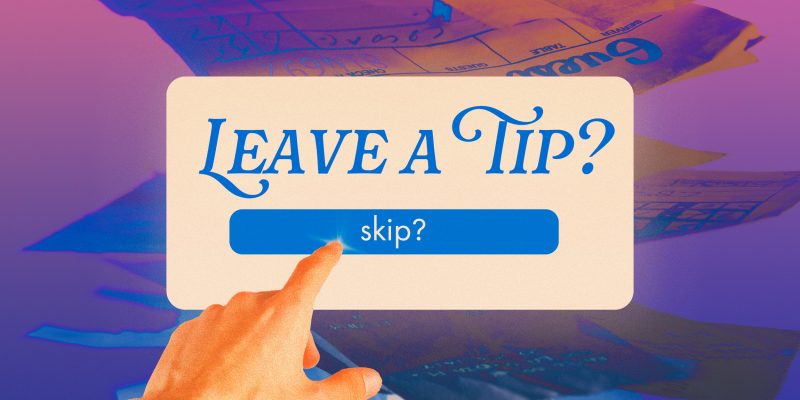“Add a tip?”
The prompts have become ubiquitous in all kinds of sales situations — from ordering a coffee to paying for a packaged sandwich — as digital card readers proliferate. But while automated requests for gratuities continue to spur confusion and grumbling, recent data suggests consumers have no trouble breezing past them.
Many people first started noticing so-called tipflation as the economy emerged from the pandemic. Venturing out again to bars, restaurants and shops, consumers were confronted with what felt like a new set of etiquette expectations — and duly began tipping more often, even as many griped loudly about it. But those upticks were modest and far from universal, and some of shoppers’ generosity now looks to be waning.
In a survey released this month by the Pew Research Center, 72% of American adults said tipping is now expected in more places than it was five years ago — but that’s pretty much all consumers can agree on when it comes to tipping.
Many dislike it when the tablets they’re presented suggest specific gratuity amounts; 40% oppose the prompts, while just 24% favor them, according to Pew.
But when consumers are left to their own devices, they take widely different approaches to deciding how much extra to offer and when to offer it, if at all. While 78% of respondents told Pew they always or often tip for haircuts, just 61% said the same of tipping their taxi or ride-hailing drivers. And only 1 in 4 reported frequently tipping baristas.
Americans can’t even agree on whether adding a tip is more of a choice or an obligation: 21% see it the first way and 29% the latter, with the remaining 49% landing somewhere in the squishy middle, saying it depends on the situation.
There’s just too many prompts now in the marketplace with these automated payment systems.
Deidre Popovich, Texas Tech University
It’s no surprise consumers are so divided and exasperated, said Deidre Popovich, a Texas Tech University professor of marketing and supply chain management who specializes in consumer behavior.
“I think there’s just too many prompts now in the marketplace with these automated payment systems,” she said. “We’re used to tipping when we can evaluate the service, and in a lot of these situations, there’s no service tied to the tip. What do we do?”
There has been some movement at the margins of Americans’ gratuity habits.
NBC News reported in February that tipping frequency was up, possibly reflecting a pandemic hangover of good vibes toward service workers when expanding point-of-sale systems made it easier for businesses to solicit tips.
The payments processor Square, which makes a popular point-of-sale platform, said the restaurant and retail workers who use its software have seen increases in tipped and overtime earnings. But the company noted that the rises have tracked broader wage increases and higher restaurant menu prices.
“We’ve definitely observed a slight increase in tipping over the last few years,” said Ara Kharazian, the research lead at Square. “But I think it’s a lot more modest than people realize, and it’s starting to slow down a lot.”
For example, the average overall earnings for restaurant workers using Square were $17.67 an hour in October, with a base wage of $13.80. That $3.87 difference, which mostly reflects tips, is only about 60 cents higher than it was in October 2021, according to the company’s payroll index.
As consumers get used to seeing tip prompts in more places more regularly, they may be getting more comfortable ignoring them — especially after having dealt with inflation-related sticker shock for many goods and services over the past year.
We’ve definitely observed a slight increase in tipping over the last few years, but I think it’s a lot more modest than people realize.
Ara Kharazian, research lead at Square
Lightspeed, another POS provider, said customers add tips on just 1.3% of in-store transactions at the retailers that have enabled its tipping feature.
While tip levels in some settings have held steady or inched higher, others are declining.
Lightspeed said the median tip at all types of restaurants using its service increased from 16.9% in the second quarter last year to 17.3% in the same period this year. But tip amounts for online orders and delivery — for which patrons can decide privately whether to tip, without service workers nearby — have dipped since last year, from about 8.8% to 8.1%.
Another point-of-sale platform, Toast, said in September that average tips at full-service restaurants declined from 19.7% in the first quarter this year to 19.4% in the second — the lowest level for that category since the start of the pandemic. Gratuities at quick-service restaurants using Toast barely ticked up to 16.1% from 16.0% over the same period.
A Bankrate survey this year found tipping frequency has continued a multiyear downslide virtually across the board. The shares of Americans who say they always tip in service transactions from food delivery to hotel housekeeping have steadily shrunk. That’s the case even at sit-down restaurants, where those who reported always tipping their servers fell from 75% in 2021 to 65% this spring.
Some companies are trying other ways to nudge customers to tip. DoorDash wrote in a blog post this month that it was testing an in-app pop-up in the U.S. and Canada to remind users of its delivery service to leave gratuities, lest they risk longer waits.
“Orders with no tip might take longer to get delivered,” the test prompt reads. “Are you sure you want to continue?”

